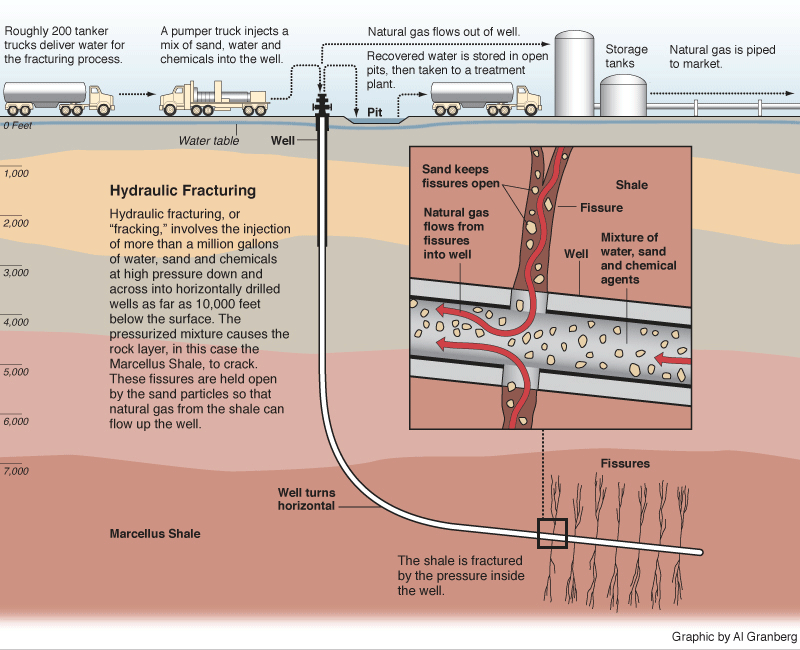PROPOSED RULE
Title: Oil and Gas; Hydraulic Fracturing on Federal and Indian Lands; Rescission of a 2015 Rule
Docket ID: BLM-2017-0001
Agency: DOI - Bureau of Land Management
Comments Close: September 25, 2017
Summary Index:
The Bureau of Land Management is proposing to rescind a 2015 rule entitled "Oil and Gas; Hydraulic Fracturing on Federal and Indian Lands." In March of 2017, the President published Executive Order 13783, which directed the Secretary of the Interior to review this specific rule 'for consistency with the order's objective "to promote clean and safe development of our Nation's vast energy resources, while at the same time avoiding regulatory burdens that unnecessarily encumber energy production, constrain economic growth and prevent job creation".' As a result of this review, the Bureau of Land Management is now 'proposing to rescind, in its entirety, the 2015 final rule.'
This proposed rule would rescind the 2015 final rule, “Oil and Gas; Hydraulic Fracturing on Federal and Indian Lands." This 2015 rule established new requirements to 'ensure wellbore integrity, protect water quality, and enhance public disclosure of chemical and other details of hydraulic fracturing operations.' The Bureau of Land Management (BLM) notes that rescinding the rule could potentially reduce assurances that operators are conducting hydraulic fracturing in an environmentally safe manner and reduce public awareness of hydraulic fracturing operations. However, there are other regulations (state and tribal) as well as 'pre-existing authorities in other Federal regulations' that would not leave hydraulic fracturing operations unregulated.
Some of the requirements for well operators dictated by the 2015 rule include: (1) Obtaining the Bureau of Land Management's approval before conducting hydraullic fracturing by submitting an application, (2) Including information about the proposed water source in each hydraulic fracturing application, (3) Include available information about the locations of nearby wells to prevent "frack hits," or unplanned surges of pressurized fluids into other wells that may damage the wells and equipment and cause surface spills, (4) Verifying that the well casing is surrounded by adequate cement, (5) test the well to make sure it can withstand the pressure from hydraulic fracturing, (6) Isolating and protecting “usable water” as defined by states and tribes, (7) Monitoring and recording the pressure during hydraulic fracturing and report significant pressure increases, (8) Submitting lists of the chemicals used (non-trade-secrets) to the BLM, and (9) Storing recovered fluids in aboveground rigid tanks of no more than 500-barrel capacity until the operator had a approved plan for permanent disposal.
The 2015 rule under consideration built upon an earlier Bureau of Land Management (BLM) rule proposed on May 11, 2012 called Oil and Gas; Well Stimulation, Including Hydraulic Fractures, on Federal and Indian Lands , amended with a supplemental notice in May 2013 because of significant public interest. Public comments, meetings with public and state officials, and tribal consultations regarding the BLM's 2012 proposed rule and 2013 notice were used to draft the 2015 final rule.
Prior to the 2015 rule, regulations designed to “ensure the environmentally responsible development of oil and gas resources on Federal and Indian lands” were 25-30 years old. Since those rules were passed, there has been a rapid expansion of the practice of hydraulic fracturing and significant technological advances in horizontal drilling. This increased public concern about whether fracturing 'contributes to or causes the contamination of underground water sources, whether the chemicals used in hydraulic fracturing should be disclosed to the public, and whether there is adequate management of well integrity and the "flowback" fluids that return to the surface during and after hydraulic fracturing operations.' The 2015 final rule responded to this public concern.
Two industry associations, four states, and a tribe challenged the 2015 rule in the U.S. District Court for the District of Wyoming in March 2015. On June 21, 2016 the District Court issued an order that set aside the rule (Wyoming v. Zinke, No. 16-8068 (10th Cir.)). They concluded that Congress revoked the BLM’s authority over hydraulic fracturing operations by enacting the Safe Drinking Water Act of 1974 and the Energy Policy Act of 2005. Both the Department of the Interior and environmental groups appealed the District Court’s decision, focusing on the primary question of whether or not the BLM complied with the Administrative Procedures Act in the 2015 rule-making procedure. ‘Briefing was completed in October 2016,’ but the appeal never made it to oral argument; ‘the Court of Appeals in a March 2017 order required the BLM to report whether it had changed its position in the appeal following the Presidential Inauguration.’
The March 2017 Executive Order 13783 “Promoting Energy Independence and Economic Growth,” directed the review four specific rules, including the 2015 final rule, for consistency with the order’s objective “to promote clean and safe development of out Nation’s vast energy resources, while at the same time avoiding regulatory burdens that unnecessarily encumber energy production, constrain economic growth and prevent job creation.” In response to the order the Department of the Interior (BLM) commenced a review of existing energy-related regulations to determine whether the rules’ changes “would be appropriate to support domestic energy production.” As a result of the review, the BLM now proposes to rescind the rule based on its believe that the compliance costs are not justified; in a previous Regulatory Impact Analysis for the 2015 final rule, the BLM estimated that compliance with the rule could cost the industry approximately $32 million dollars annually.
'In sum, the 2015 final rule has never gone into effect, and was set aside by the District Court on June 21, 2016.'
Contributor: PhD Candidate, Earth and Space Sciences





